Pig Breeds – which and why?
Animals kept outdoors need to:
• have a more robust constitution to withstand climatic extremes
• be able to exhibit appropriate ranging behavior, and
• be able deal with social competition for resources such as feed or shelter (Edwards, 2005).
What are the breed issues we need to think about?
Which Breed?
Breeding for Health and Welfare
Selecting the Right Mother
Crossbreeding
Which Breed Should I Choose?
Choice of breed and cross-breed will frequently depend on finding a balance between productivity, suitability to outdoor conditions and market suitability. The traits important for a good outdoor sow are: prolificacy, good maternal instincts, good fat reserves to provide both protection against weather and energy reserves for an active outdoor life, and independence combined with ease of handling (Blair, 2007). Boars need to be able to withstand the outdoor conditions as well. They need to be able to mate without assistance but to be docile enough to fit into group management.
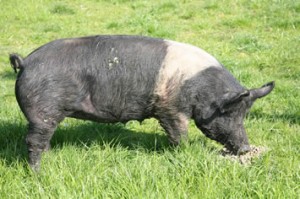 Hampshire (www.thepigsite.com)
Hampshire (www.thepigsite.com)
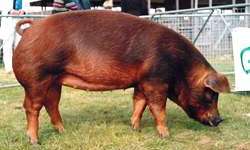
Duroc (www.thepigsite.com)
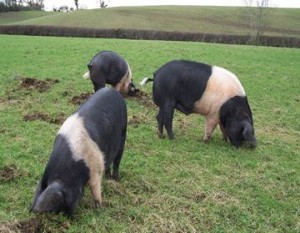
Saddleback (www.forthillfarm.co.uk)
Different breeds and crosses will possess different characteristics, and only some will have traits suited to outdoor and sustainable production. Breeds such as the Hampshire and Duroc enhance meat quality and tend to be used as boars. Crossbreeding the Duroc breed with Landrace or Large White at typical inclusion of 12.5% to 25% Duroc genes to the slaughter generation is a standard approach to introducing robustness to commercial outdoor pig herds (Edwards, 2005). Inclusion of the Duroc also increases some of the quality characteristics desired in fresh, outdoor produced pig meat, including darker, redder muscles and increased tenderness.
There tends to be more breed diversity in organic farming , and breeds such as the Saddleback are common (Hovi et al., 2001). These breeds have higher levels of body fat and suffer less metabolic stress when exposed to lower quality of feeds, which seasonally may be the case on a larger forage based diets.
Traditional breeds like Tamworth and Saddleback tend to do well in free range systems with the Berkshire and Gloucester Old Spot also being well suited, the latter being a particularly good forager. Breeds with a pigmented skin will suffer much less from issues such as heat stroke or sun burn that can be a problem in free range systems. One of the disadvantages of native or traditional breeds is that they tend to lay down more fat than is required by consumers. There is evidence to show that modern genotypes are better suited to the indoor environments that they have been selected for (Kleinbeck and McGlone, 1999). Modern hybrids tend to have more piglets born alive (see also Litter size), which can be a negative characteristic in some systems. Rather than selecting for large litters, selection for a small litter size may be more appropriate and may fit more easily with herd management. Modern hybrids also tend to produce a leaner carcass.
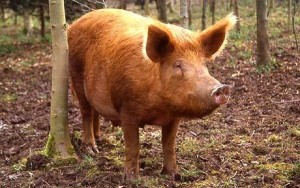
Tamworth (www.telegraph.co.uk)
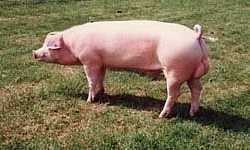
Landrace (www.thepigsite.com)
A comprehensive description of a wide number of pig breeds is available at other sites, including www.thepigsite.com.
Breeding for Health and Welfare
Developing breeding goals for sustainable pig production that encompass health and welfare traits is not straightforward. Pig breeding programs traditionally focus on the genetic improvement of production and reproduction traits that have a clear economic value and place less importance on traits of more societal value, including welfare (Kanis et al., 2005).
Traits related to animal welfare and health are classified by Kanis et al. (2005) into the following categories:
1) temperament, including aggressiveness, activity, curiosity, and docility;
2) stress resistance, such as fearfulness, nervousness, and flexibility; and
3) robustness, including bodily soundness and fitness and disease resistance, enabling pigs to adapt to changing environmental management and health conditions.
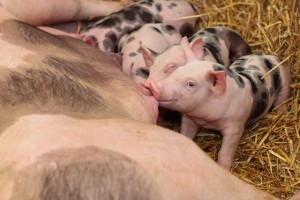
Behaviors such as performed aggression in sows is a heritable trait, and selection against aggression is possible without impacting on maternal behavior (Lovendahl et al., 2005).
There is ample evidence that in general these traits have sufficient genetic variation for successful selection. However, there is a need to clearly define a limited number of representative welfare and health traits for which sufficient data can be routinely obtained (Kanis et al., 2005).
A breeding goal which emphasizes the important traits of mothering ability and sow longevity has been shown to improve welfare of outdoor reared pigs this has negative impacts on the breeding progress for growth rate and leanness of pigs raised for slaughter (Gourdine et al., 2010). Consequently, and to be relevant, a welfare breeding programme for outdoor production requires higher price for systems that achieve high standards of welfare.
Outdoor reared pigs are significantly more at risk of internal parasite infestation than indoor reared animals. While the practise of selection for resistance is not well established, the increase in parasitic resistance to anthelmintics suggests that there is an increasing need to start using more resistant genotypes for breeding (Nejsum et al., 2009; Roepstorff et al., 2011).
Genetic variation for piglet survival exists and hence selection for increased survival is possible. However, for a successful selection program it is necessary to record survival. Although they are correlated, sole recording of birth weight is not sufficient (Knol, 2001).
Kanis et al. (2004) propose that breeding candidates should be tested under ‘hard’ conditions and selected on their coping success. Various behavioral tests and operant conditioning tests to test a pig’s motivation to change its actual environment could also be carried out. On the farm, problems associated such as how animals cope with the incidences of certain diseases, injuries and stereotypies, as well as longevity, ease of handling, certain blood parameters as well as some production traits could be recorded routinely and used to select for improved pig welfare.
Selecting the right mother
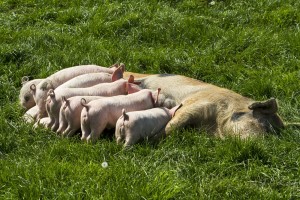
Mothering ability can be more critical in outdoor conditions than in protected and restricted indoor housing
Breed selection programs for intensive pig production have over many years emphasized productivity and especially product quality i.e. fat content over welfare related characteristics, and in particular maternal behavior. This is largely because it has been possible to control piglet loss that may result from poor mothering by placing sows in highly controlled conditions. These maternal characteristics become much more important in extensive, outdoor systems which place high emphasis on natural behavior. Selection for good maternal behavior and piglet rearing ability results in greater productivity as well as higher standards of welfare.
There are other characteristics of intensive indoor systems that do not promote good mothering abilities. The greater leanness of some modern genotypes means that they have less protection against climatic extremes as they lack adequate thermal insulation. Also, these breeds have limited possibility to mobilize body fat reserves to support the high metabolic demands of lactation. This situation is made worse in systems that have longer weaning age as part of their high animal welfare requirements e.g. organic systems. Longer lactations mean there are greater metabolic demands on the sow, which can result in ‘thin sow syndrome’ (ADAS, 2002).
There is more information on mothering behavior in the section on piglet rearing.
Cross-breeding
One of the key practises we promote is that of operating closed herds, which has implications for breeding policy. Traditionally in intensive systems number of different pure breeding lines have been used at nucleus level by companies to generate hybrid sire and dam lines for use in commercial pig meat production. This brings the benefits of heterosis or hybrid vigour, which results in improved performance of the hybrid offspring. However, in closed herd situations, purebred lines are required to rear replacement breeding animals, and the ability of a herd to maintain high quality replacements will be dependent on the size of the herd – smaller herds would struggle to maintain quality with small populations to select from. A solution would be to adopt a ‘within-herd’ criss-cross breeding policy, which does not give as much performance benefit as using a first-cross dam, but does allow improvements within a closed herd (Bichard and Davies, 1986 and ADAS, 2002).
There are various acceptable breeds options for crossbreeding, including Saddleback X Duroc that appears to meet the requirements for carcass quality, hardiness and reproductive performance (ADAS, 2002).


 British English
British English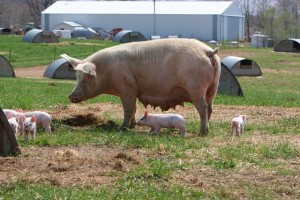
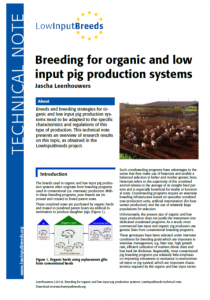
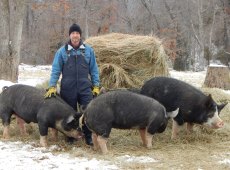
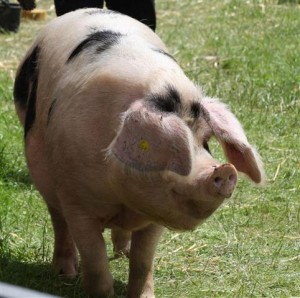


Comments are closed.